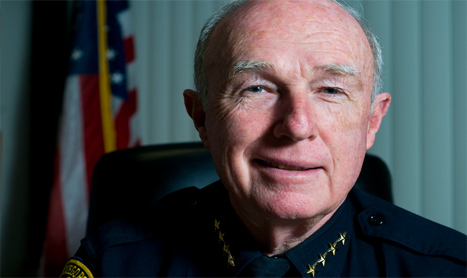
By Kimetha Hill
Staff Writer
The San Diego community has responded loudly and clearly to address the racial profiling issue that has plagued the City. The San Diego Police Department has been under fire due to countless incidences of racial profiling during traffic stops of the black and brown communities. Recently, police Chief William Lansdowne has pledged to reinstate the department’s data tracking for traffic stops. But many residents are skeptical, and feel there needs to be a greater shift in policy.
Last Thursday, the San Diego NAACP hosted Chief Lansdowne at their monthly membership meeting to address concerns from the community with regards to racial profiling. And though the gathering was intimate in number, the concerns and experiences spoke volumes, and have surely been echoed among San Diego’s entire community of color.
“What is the protocol for stopping young, black men?” asked a concerned mother, whose son was pulled over driving her car and immediately accused of possessing drugs in the vehicle. The only answer given to her was, “that it has to be a legal stop.”
Chief Lansdowne gave a brief history of his experience as a police chief, discussing his partnership with former San Diego Mayor, Jerry Sanders, and their development of a policy and procedure for tracking instances of racial profiling. He tried to soothe the audience’s angst by mentioning the department’s commitment to 140 community meetings per month. “We get approximately six complaints per year,” said Lansdowne on the number of racial profiling complaints.
But communities of color know otherwise.
One young gentleman who resides in the Bayview Apartments expressed his frustration and anger of being stopped and patted down every time he walks by the police substation; though he is not in a gang and has no criminal record. “What is the law – when is it legal to draw your weapon on a person?” he questioned. To his frustration, he was only encouraged to file a complaint. And that each case is examined on a case by case basis. But the accused must first survive the attack – and only if they survive – can they file.
“The record keeping criteria includes traffic and pedestrian location, who was involved, the reason for the stop, and of course ethnicity,” said Lansdowne. He went into detail on the proposed cameras that will be physically mounted on the officers during their shifts. “The cameras create a system of trust,” he said. “The numbers don’t mean a lot [in reference to data tracking]. We need actual evidence.” Lansdowne emphasized that support must come from community involvement.
Still, community members were not yet sold on the cameras. “How will the cameras stop racial profiling?” questioned one concerned resident. Lansdowne reiterated the support of evidence, but with the cost of $200,000 a year for 100 cameras, residents are not satisfied that a change will come.
Captain of the Southeast Division Police Department, Tony McElroy also offered advice and encouragement to the community present, many of whom live in southeast neighborhoods – problem areas where racial profiling runs rampant. “I encourage the community to come to police lineups and tell us how you want to be policed. In the street is not the time to debate with the officer.” McElroy is retiring in June, and has built a solid rapport in the neighborhood in which he works.
“Living while Black in San Diego – not driving while Black – this idea that you can ask for a supervisor… The only thing you can do is what you said, survive the incident, because 90 percent of this stuff is premeditated. These cops are trained, they have the intention of getting you emotionally aroused; and causes the situation to go from an encounter, to an altercation to a felony. And that’s by design,” said Dr. Warren, Publisher of the Voice & Viewpoint Newspaper.
Police Chief Lansdowne expressed that there will be continued training within the department to hopefully curb the instances of racial profiling, eventually eradicating the problem completely. For now, data tracking of traffic and pedestrian stops has been reinstated.

